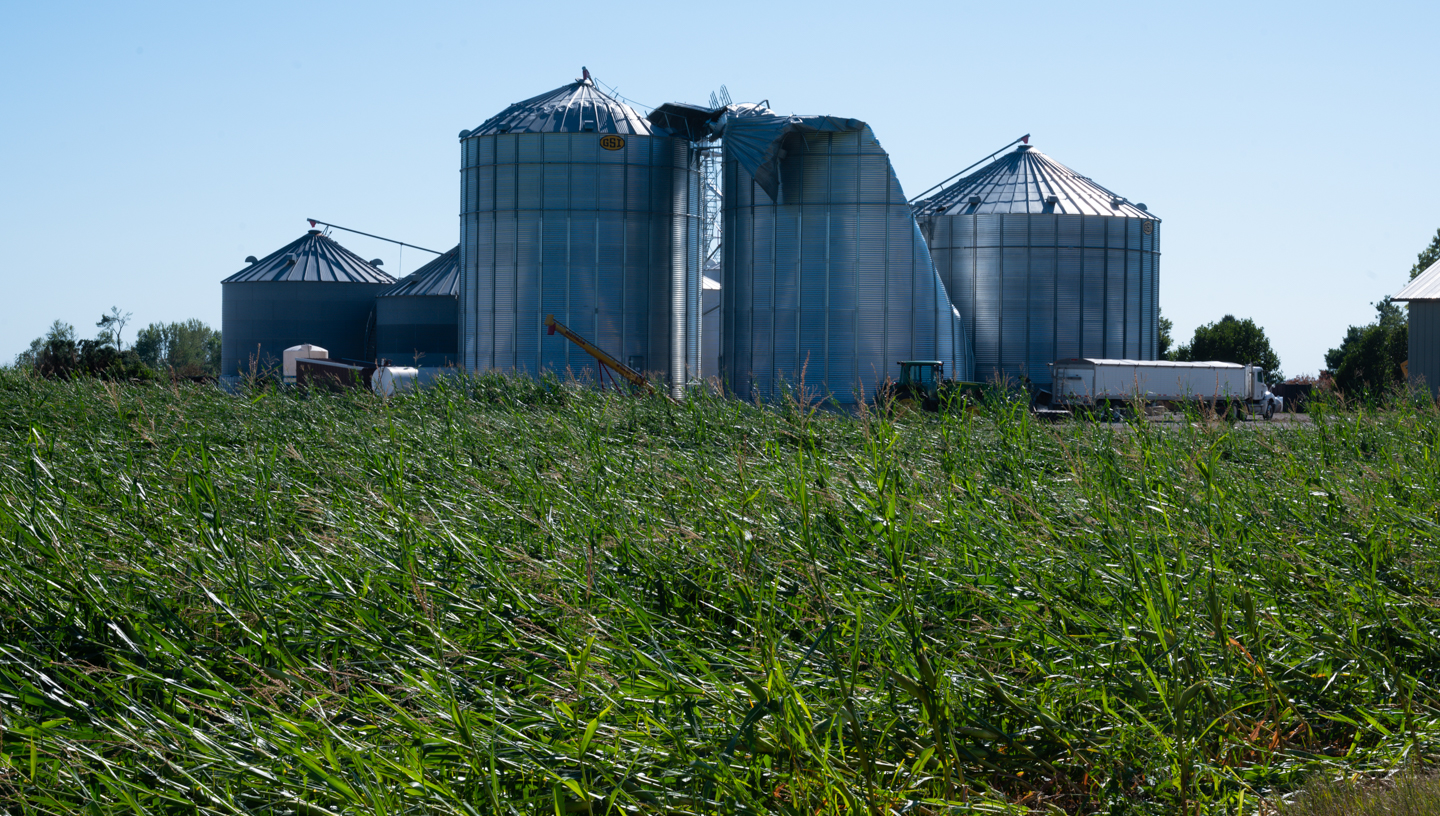
A strong derecho devastated corn fields like this one north of Ankeny on Monday. (Photo: Joseph L. Murphy/Iowa Soybean Association)
One-third of Iowa cropland, millions of bushels of grain storage adversely impacted by Monday storm
August 11, 2020 | Aaron Putze, APR
A challenging year for Iowa farmers became even more of a burden when a non-forecasted weather phenomenon called a “derecho” carved a swath of destruction across large portions of the state Monday (Aug. 10).
Iowa ag officials estimate nearly one-third of Iowa’s cropland – or almost 10 million acres of soybeans and corn – sustained damage. The impact on permanent grain storage is still being calculated, with early estimates starting at 25 million bushels.
Officials say it could take weeks until the full scope and financial impact of the storm is tallied.
“Its impact stretched from one river to the other,” said Iowa Secretary of Agriculture Mike Naig. “There are too many locations in Iowa that are tough to look at.”
A derecho is a widespread, thunderstorm-induced windstorm that strengthens as the complex of cells that comprise it tighten. It’s characterized by widespread, long-lived, straight line winds capable of reaching hurricane force.
State climatologist Justin Glisan says the derecho that entered Iowa around 8 a.m. Monday formed earlier in the day over southern South Dakota.
As it moved east, the storm complex steered into a warm air mass with very strong winds aloft. It quickly turned into a wall and front as it marched eastward, covering an area bordered by roughly Highway 20 on the north to I-80 to the south.
When the storm complex arrived in central Iowa shortly before 11 a.m., the derecho boasted winds exceeding 100 miles per hour. As the storm proceeded into eastern Iowa, its coverage area expanded along with its intensity.
“This was Iowa’s version of a Cat-I or II hurricane,” Glisan said.
By the time the storm disbanded in western Ohio late in the day, it had held together for 14 hours and trekked nearly 800 miles traveling at an average speed of 55 miles per hour. Rainfall amounts along the storm’s path ranged from a few tenths to several inches with some locations impacted by hail.
By Tuesday, work had begun on a U.S. Department of Agriculture secretarial designation to aid those impacted by the storm. Given no weather disaster legislation is currently in place for 2020 relating to the derecho or other storms, Congress will need to act.
The secretarial designation pertaining to crops and facilities will serve as the underpinnings of any pending legislation.

Damage to grain bins and outbuildings was widespread near Sheldahl, Alleman and Huxley after the Monday storm. (Photo: Joseph L. Murphy/Iowa Soybean Association)
Gov. Kim Reynolds issued a disaster proclamation Tuesday for several counties impacted by the storm. It allows counties to use state resources to proceed with storm recovery and suspends some regulatory provisions to allow clean-up crews to respond to damage throughout the state.
“Our thoughts and prayers are with all who have been affected by the storm,” she told farmers attending a Beck’s Hybrids field day held near Colfax Tuesday. “Iowa farmers feed the world and it’s essential that we keep business open, from the farm to the processor to the grocery stores.”
Naig, like the governor, was traveling Iowa roadways Tuesday personally assessing the extent of damage.
“What I saw was horrific,” he said while traveling through portions of Story County.
Corn fields in the storm’s path were especially hard hit, particularly with those with rows running north and south. Many fields were flattened and in the worst cases, stalks were snapped. Soybean fields also sustained damage, although the severity and extent of crop loss is less certain given the crop has time to mature and recover.
In addition to grain storage being severely impacted, some turkey and poultry barns sustained structural damage. Loss of electricity in some municipalities and rural locations hindered local feed mill operations.
Naig encouraged farmers to report grain storage damage to the Iowa Department of Agriculture.
“We also urge farmers to be safe as they begin making repairs and picking up the pieces,” he added. “Let’s not compound this situation with injuries.”
Putze serves as Iowa Soybean Association Sr. Director of Information & Education. He can be reached at aputze@iasoybeans.com.
Back